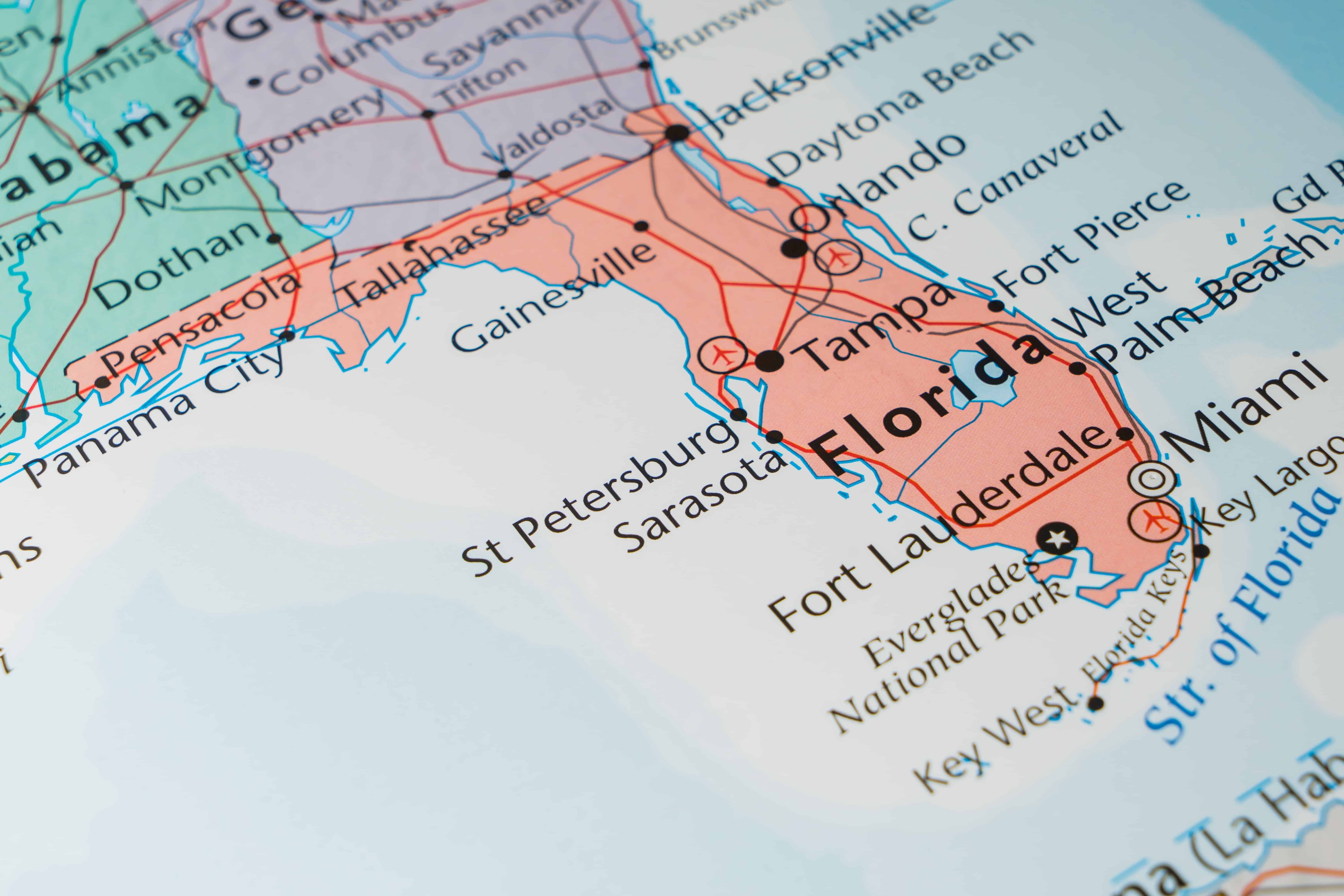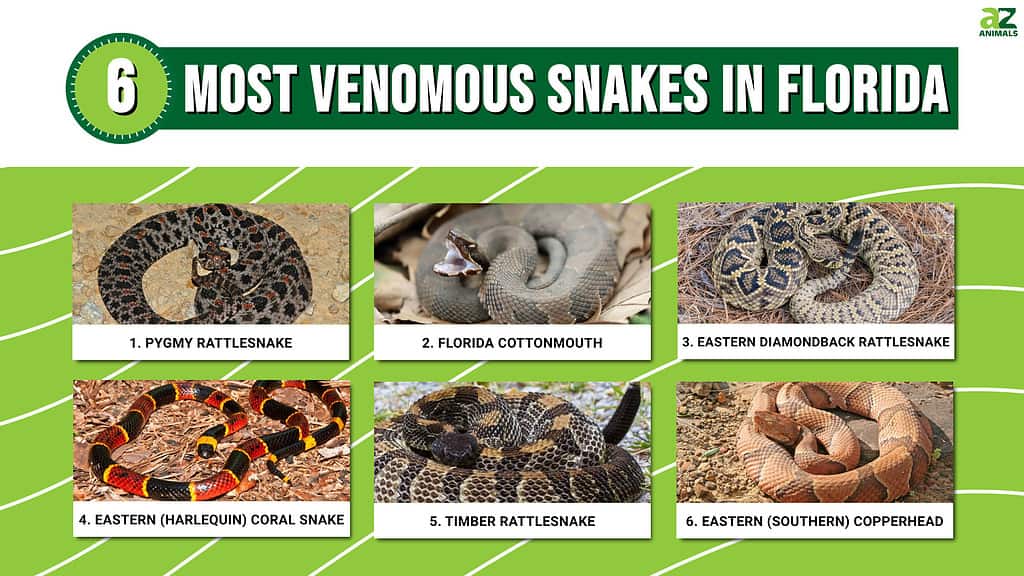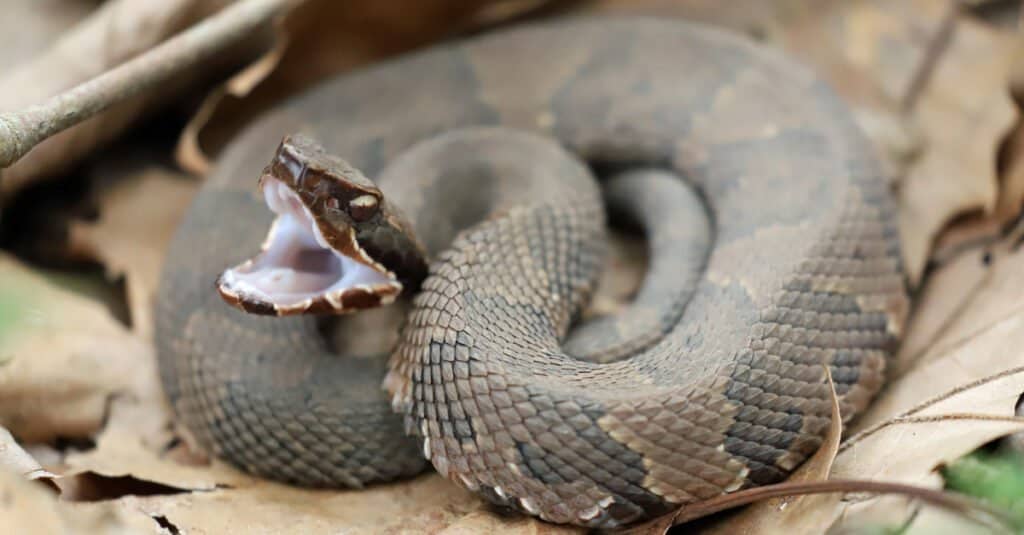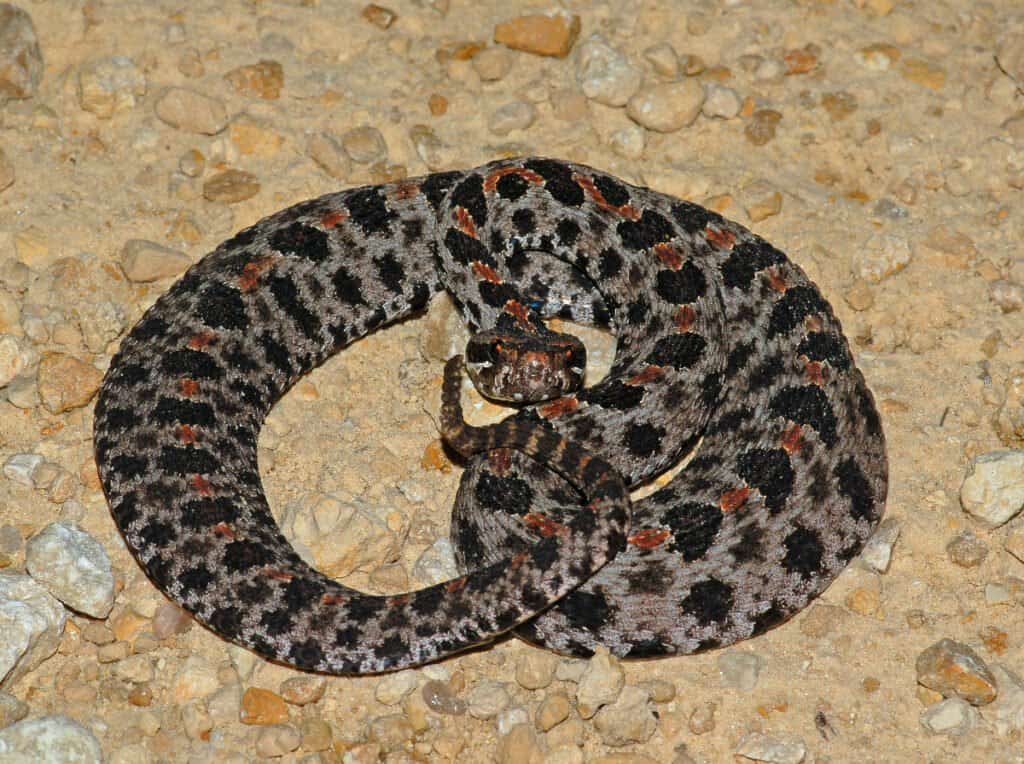
There are 44 different species of snakes in Florida, but only 5 of those are venomous.
©Alexander Lukatskiy/Shutterstock.com
Although the fear of being bitten by a snake is real, the incidents of snake bites are actually pretty small. If you see a snake your first thought may be, is that poisonous? There are 44 different species of snakes in Florida, none of those snakes are poisonous, but six are venomous. How can I tell if a snake is venomous? Where do the venomous snakes live in Florida? Let’s find out about the 6 most venomous snakes in Florida!
Does Poisonous Mean Deadly?

Snake bites are not likely to be fatal. Medical facilities are equipped with antivenom to prevent deaths.
©iStock.com/DaveGartland
First, a point of clarification: while some sources use the words poisonous and venomous interchangeably, almost all snakes are actually venomous. You can read our explanation on venomous animals vs. poisonous ones, but the short story is venom is injected whereas poisons can be inhaled, eaten, or touched. Yet, we see thousands of searches each year on poisonous snakes on A-Z Animals, so we want to address reader concerns which boils down to: snake bites can have serious medical implications!

Venemous does not necessarily mean deadly. In the United States, medical facilities are equipped with antivenom so the incidents of fatalities are extremely low. According to the CDC, 7,000-8,000 people are bitten by venomous snakes each year in the US, but only an average of 5 are fatal. Some snakes are more venomous, some are more aggressive, and some are less likely to interact with humans. Let’s look at some of the least common to most common poisonous snakes in Florida.
6) Eastern (Southern) Copperhead

The Eastern Copperhead snake is found in the panhandle of Florida.
©Creeping Things/Shutterstock.com
The Eastern Copperhead, sometimes called the Southern copperhead, is found in a small area around the panhandle of Florida, so you are unlikely to come across one. It is only in the northwestern part of the state between the Apalachicola River (just west of Tallahassee) and Pensacola. These snakes are 2-3 feet long and are tan with dark brown hourglass markings that blend in well with dried leaves. Like other pit vipers they have a triangle head and vertical slits in their eyes, similar to cat eyes. They cause almost half of the venomous snakebites in the U.S. annually, but their venom is less dangerous than the cottonmouth and timber rattlesnake.
5) Timber Rattlesnake

Timber Rattlesnakes are in the Northeast part of Florida.
©Frode Jacobsen/Shutterstock.com
The Timber rattlesnake is pretty rare in Florida as well. It is only located in the northeast part of the state and prefers moist habitats like floodplain forests. The average one can get to be 3-5 feet long and is the third largest venomous snake in the US. It is yellow-gray in color with blackish-brown, arrow-shaped markings and has a reddish-brown stripe that goes down the length of its body. Also a pit-viper, its head is triangular and has two pits or openings on the side of its head to sense prey.
As rattlesnakes, they have a rattle at the end of their tails that they shake as a warning to other animals (and humans). Their venom is strong enough to kill a human, but they are docile and prefer to remain still and hope you don’t see them. If they feel threatened they can strike. If you do get bitten you need to seek medical attention immediately.
4) Eastern (Harlequin) Coral Snake

Coral snakes are black, red, and yellow banded, and can be found throughout Florida.
©iStock.com/JasonOndreicka
The Eastern Coral Snake, sometimes called the Harlequin snake, is a venomous snakes that is not a pit viper. It is located throughout Florida, but in drier habitats so you won’t find them in marshes or swamps. Eastern Coral snakes are smaller and thinner, about the diameter of a pencil, some are a little thicker and are about 1 meter (3.3 feet) long. They are easily recognized by their bright black, red, and yellow banding. Although there are other snakes with the same coloration, including non-poisonous ones like the Scarlet King snake, it is probably safest to stay away from any snake with this coloration. Instead of a quick piercing bite with fangs like a rattlesnake, these snakes have to chew on their victim to pass on the venom. So be sure to never handle a Coral snake.
3) Eastern Diamondback Rattlesnake

Eastern diamondback rattlesnakes are the largest poisonous snake in Florida.
©Chase D’animulls/Shutterstock.com
The Eastern Diamondback rattlesnake is the largest poisonous snake in Florida and also one the most deadly in the United States. It is much more common and can be found in every county in Florida. Diamondbacks are capable of swimming, so they have made their way to some of the islands in and around the Keys. They are large-bodied and are 5-6 feet long, although the longest one on record was 8 feet. They are brown in color with dark brown diamond-shaped markings along their back. As rattlesnakes, they have a rattle at the end of their tail they use to warn others.
If you came across one on a trail they would probably remain in a coiled position and you would have time to slowly back away. If they felt threatened, or you tried to approach one they may rattle their tail as a warning, raise the front of their body up and as a last resort strike. Although large, they are not aggressive, but if you get bitten, you should seek immediate medical attention.
2) Florida Cottonmouth

Cottonmouth snakes can be found in lakes, rivers and waterways throughout Florida.
©KF2017/Shutterstock.com
If you think you will be safe from venomous snakes if you just stay off hiking trails you are wrong. What about swimming in a lake or river? You will have to look out for the Florida cottonmouth or sometimes called a water Moccasin. While most of the snakes on our list prefer to be left alone and will give fair warning, cottonmouths are aggressive. They seem to have a short temper. They may coil back, open their mouths, and show their fangs before striking.
Cottonmouths are found throughout the state of Florida and can be found in lakes, rivers, swamps and retention ponds. They are heavier-bodied snakes that can be 2-4 feet long and are black in color. They are called cottonmouths because of the white interior of their mouths. There are other water snakes that look similar but are not venomous but it is safest to stay away from all water snakes.
1) Pygmy Rattlesnake

The Pygmy Rattlesnake may only be 1-2 feet long but they are poisonous.
©Gerald A. DeBoer/Shutterstock.com
Don’t be fooled by the size of this little rattlesnake. Although it is the smallest rattlesnake, it is venomous and can cause a painful bite. It is found throughout Florida and prefers forests and wooded areas. Pygmy rattlesnakes are thick, but shorter with most being 1-2 feet long. Their bodies are tan with dark brown splotches and a pinkish-brown stripe down the length of their back. The Pygmy rattlesnake is responsible for the most snake bites of venomous snakes in Florida. It is common and because of its size, children often pick it up without knowing the snake is venomous. Sometimes this results in the children getting bitten. These snakes are not aggressive and will flatten out to hide in the brush versus striking outright. If you do get bitten or your children does, you should seek immediate medical attention.
Other Snakes in Florida
If you want to learn about more snakes in Florida, click on this link to an article about 10 Snakes in Florida, 8 of which are different from the ones listed on this page. They are: the eastern mud snake, the ring-necked snake, the Brahminy blind snake, the eastern indigo snake, the Florida pine snake, the Florida kingsnake, the Florida banded water snake, and the Burmese python.
As you can probably tell from their names, there is quite a variety among these snakes. The climate and terrain in Florida are perfect for snakes, and prey is abundant, so venomous and non-venomous snakes in a rainbow of colors, make their various homes there.
The photo featured at the top of this post is © iStock.com/Tee-roy
Discover the "Monster" Snake 5X Bigger than an Anaconda
Every day A-Z Animals sends out some of the most incredible facts in the world from our free newsletter. Want to discover the 10 most beautiful snakes in the world, a "snake island" where you're never more than 3 feet from danger, or a "monster" snake 5X larger than an anaconda? Then sign up right now and you'll start receiving our daily newsletter absolutely free.
Thank you for reading! Have some feedback for us? Contact the AZ Animals editorial team.






